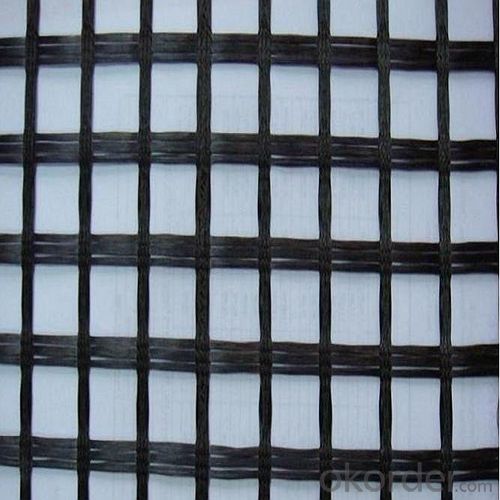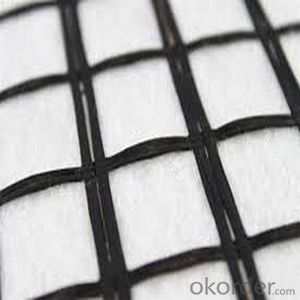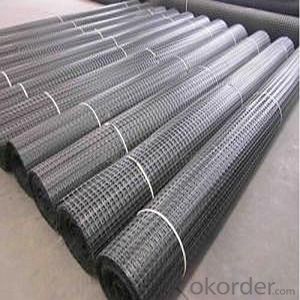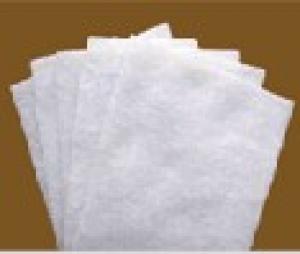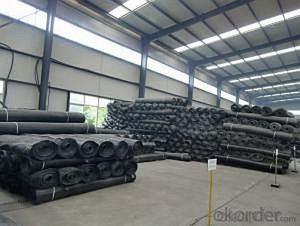Geotextil Precio Colombia - Fiberglass Geogrid Roadbed Reinforcement with Low Elongation and Good Toughness
- Loading Port:
- China main port
- Payment Terms:
- TT OR LC
- Min Order Qty:
- 1000 m²
- Supply Capability:
- 1000000 m²/month
OKorder Service Pledge
OKorder Financial Service
You Might Also Like

Products Description
Geogrids with gravel chippings for fill material provides horizontal stability of the road surface bed (fixation of gravel chippings under surface to prevent horizontal rupture).
Geogrid application allows using gravel chippings of different kinds.
Geogrid application filled with ground material is one of the easy of soil reinforcement.
The thickness of such construction may be 50% less than the thickness of standard replacement which allows avoiding costly soil replacement.
Tensile Strength: 25-25KN; 30-30KN; 50-50KN; 80-80KN; 100-100KN; 120-120KN;
Road Size: 3.95x100m; as customer required;
Application
1. Roadbed reinforcement in highway, railway and municipal road, prevent road surface crack
2. Reinforcement and separation in dam and river, improve soft soil bearing capacity and stability.
Application
1. Roadbed reinforcement in highway, railway and municipal road, prevent road surface crack
2. Reinforcement and separation in dam and river, improve soft soil bearing capacity and stability.
fiberglass geogrid/glass fiber geogrid with CE certificate Introduction: Fiberglass geogrid is a kind of new favorable earthwork base material to strengthen the road surface and roadbed. This product is composed of fiberglass filaments that are coated with an inorganic sizing agent
Our Service
Quality assurance
1.On a regular basis or as per your request,we entrust national testing agencies to conduct quality inspections
2. Strictly in accordance with the ISO9001-2008 international quality system standard,we monitor and manage the whole process throughout production,quality testing,and measurement to ensure product quality
3. For quality-related construction delay or substandard construction(except for damage or losses due to customer’s responsibility or irresistible natural disasters),we have refunding,replacement,and repair services.We will respond to customers’ feedbacks on quality issues within 24 hours.
Packaging & Shipping
Packing: PLASTIC FILM INSIDE, AND WOVEN BAG OUTSIDE
Shipping: About 15 days after receipt the deposit
FAQ:
Q: What kind of payments does jenor support?
A: T/T, L/C, Cash are accepted.
Q: Do you charge for the samples?
A: Accordeing to our company policy, the samples are free, we only charge the freight fee. And we will return the freight fee during the next order.
Q: Can you produce according to customers' design?
A: Sure, we are professional manufacturer, OEM and ODM are both welcome.
Q: Do you have other products?
A: Yes, please check the pictures:
- Q: Geotextile CBR tear strength rate is how much
- Geotextile CBR bursting strength is generally in accordance with the national standard GB / T-2017 "geosynthetics static top breaking test (CBR method)" according to the national standard GB / T-2017 standard requirements of geotextile CBR strong pre-tension 20N. According to the national standard GB / T-2017 standard requirements of geotextile CBR strong rate of (50 ± 5) mm / min.
- Q: How do geotextiles improve the performance of geocells?
- Geotextiles improve the performance of geocells by providing additional reinforcement and stability to the structure. They act as a barrier against soil erosion and help distribute loads evenly, increasing the overall strength and durability of the geocell system. Additionally, geotextiles prevent the mixing of different soil layers, enhancing filtration and drainage capabilities.
- Q: Geotextile, one ton, replaced by a square meter how much money formula
- First look at how many grams of cloth, and then in addition to the number of square feet on how much money and then divided by the square to know how much money a square I plant geotextile
- Q: Can geotextiles be used in geotechnical engineering projects?
- Yes, geotextiles can be used in geotechnical engineering projects. Geotextiles are synthetic fabrics that are permeable and have the ability to stabilize soil, control erosion, and improve drainage. They are commonly used in geotechnical engineering applications such as road construction, slope stabilization, and landfills to enhance the performance and durability of the soil.
- Q: What glue can clay stickers glue?
- Geotextiles generally do not need to glue glue, because the geotextile is made of polyester staple fiber acupuncture, the product itself has a lot of small pores, the use of glue bonding not only a waste of glue, bonding effect is not good. Geotextile in the project is generally used in the hand-type sewing machine suture, suture geotextile not only glue glue than the geotextile solid and reliable, and the construction of geotextile suture is also much higher than the construction of glue with geotextile Speed, while the cost of sewing geotextile is also much lower than the cost of glue bonding geotextile. Generally in the project to play the effect of impervious geomembrane, composite geomembrane (also known as composite geotextile) can use glue bonding. Adhesive glue can be purchased in the geomembrane manufacturer, of course, you can also buy in the local building materials market, waterproof plastic or KS geomembrane special glue. These two glue can also be used to bond geotextiles.
- Q: Supply Tianhe District staple geotextile and anti-geotextile what is the same
- Staple geotextile is made of polyester staple fiber by acupuncture, because it can play the role of anti-filtration, and thus staple geotextile can also be called anti-geotextile. Filter geotextile is based on the use of the name, so long as it is able to play the role of anti-filter geotextile called geotextile filter, geotextile, including geotextile geotextile, filament geotextile, the preparation of geotextile, Woven geotextile, non-woven geotextile, polypropylene geotextile. Tianhe District used staple geotextile and anti-filter geotextile is the same.
- Q: What are the composite geomembranes suitable for use? What are the characteristics of it? There are several kinds of composite geotextiles?
- Widely used in water conservancy, chemical industry, construction, transportation, subway, tunnel, garbage disposal field and other anti-seepage project, high puncture resistance, large coefficient of anti-aging performance, to adapt to the environmental temperature range Excellent anti-drainage performance Geotextile: A cloth a film two cloth a film a cloth two films more cloth film and so on
- Q: What are the advantages of using geotextiles in green building design?
- Geotextiles offer several advantages in green building design. Firstly, they help in erosion control by preventing soil erosion and protecting the surrounding environment. Secondly, geotextiles act as a filtration system, promoting water drainage while retaining fine particles, thus enhancing water quality. Additionally, they provide stability and reinforcement to the soil, ensuring the structural integrity of the building's foundation. Geotextiles also aid in weed control by preventing the growth of unwanted vegetation. Lastly, these materials are often made from recycled materials, making them an eco-friendly choice for sustainable construction practices.
- Q: Are geotextiles environmentally friendly?
- Yes, geotextiles are environmentally friendly. They are made from natural or synthetic fibers that are biodegradable and do not release harmful substances into the environment. Geotextiles also help to prevent soil erosion, promote vegetation growth, and improve water quality, making them a sustainable solution for various environmental applications.
- Q: What are the advantages of using geotextiles over traditional construction materials?
- There are several advantages of using geotextiles over traditional construction materials. Firstly, geotextiles are lightweight and flexible, making them easier to handle and install compared to heavier materials like rocks or concrete. This results in reduced labor and transportation costs. Secondly, geotextiles offer excellent filtration and drainage properties, allowing water to pass through while preventing the migration of fine particles. This helps in stabilizing the soil and preventing erosion, which is particularly beneficial in areas prone to heavy rainfall or water runoff. Additionally, geotextiles provide increased strength and reinforcement to the soil, enhancing overall stability and load-bearing capacity. This is especially useful in areas with weak or unstable soils, where traditional materials may not provide adequate support. Furthermore, geotextiles are resistant to biological degradation, chemicals, and UV radiation, ensuring long-term durability and reducing the need for frequent maintenance or replacement. Overall, the use of geotextiles in construction offers cost-effective, sustainable, and versatile solutions for various soil-related challenges, providing numerous advantages over traditional construction materials.
Send your message to us
Geotextil Precio Colombia - Fiberglass Geogrid Roadbed Reinforcement with Low Elongation and Good Toughness
- Loading Port:
- China main port
- Payment Terms:
- TT OR LC
- Min Order Qty:
- 1000 m²
- Supply Capability:
- 1000000 m²/month
OKorder Service Pledge
OKorder Financial Service
Similar products
Hot products
Hot Searches
Related keywords






